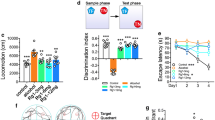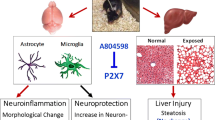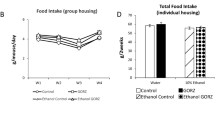Abstract
Glucagon-like peptide 1 (GLP-1) analogues have been commercialized for the management of type 2 diabetes. Recent studies have underscored GLP-1’s role as a modulator of alcohol-related behavior. However, the role of the GLP-1 analogue liraglutide on alcohol-withdrawal responses have not been fully elucidated. Liraglutide binds to the G-protein-coupled receptor and activates an adenylyl cyclase and the associated classic growth factor signaling pathway, which acts growth factor-like and neuroprotective properties. The underlying neurobiological mechanisms of liraglutide on alcohol withdrawal remains unknown. This study endeavored to explore the effects of liraglutide on the emotion and memory ability of alcohol-withdrawal mice, and synaptic morphology in the medial prefrontal cortex (mPFC) and the hippocampus (HP), and thus affects the relapse-like drinking of alcohol-withdrawal mice. The alcohol-withdrawal group was reintroduced to a 20% v/v alcohol and water through the two-bottle choice for four consecutive days, a period referred to as alcohol re-drinking. Male C57BL/6J mice were exposed to a regimen of 20% alcohol and water for a duration of 6 weeks. This regimen established the two-bottle choice model of alcohol exposure. Learning capabilities, memory proficiency, and anxiety-like behavior were evaluated using the Morris water maze, open field, and elevated plus maze paradigms. Furthermore, synaptic morphology and the levels of synaptic transport-related proteins were assessed via Golgi staining and Western Blot analysis after a two-week alcohol deprivation period. Alcohol re-drinking of alcohol-withdrawal mice was also evaluated using a two-bottle choice paradigm. Our findings indicate that liraglutide can substantially decrease alcohol consumption and preference (p < 0.05) in the alcohol group and enhance learning and memory performance (p < 0.01), as well as alleviate anxiety-like behavior (p < 0.01) of alcohol-withdrawal mice. Alcohol consumption led to a reduction in dendritic spine density in the mPFC and HP, which was restored to normal levels by liraglutide (p < 0.001). Furthermore, liraglutide was found to augment the levels of synaptic transport-related proteins in mice subjected to alcohol withdrawal (p < 0.01). The study findings corroborate that liraglutide has the potential to mitigate alcohol consumption and ameliorate the memory impairments and anxiety induced by alcohol withdrawal. The therapeutic efficacy of liraglutide might be attributed to its role in counteracting synapse loss in the mPFC and HP regions and thus prevented relapse-like drinking in alcohol-withdrawal mice.









Similar content being viewed by others
Data Availability
All data generated or analysed during this study are included in this article. Further enquiries can be directed to the corresponding author.
References
Merikangas KR et al (1998) Comorbidity of substance use disorders with mood and anxiety disorders: results of the International Consortium in Psychiatric Epidemiology. Addict Behav 23(6):893–907
Peacock A et al (2018) Global statistics on alcohol, Tobacco and illicit drug use: 2017 status report. Addiction 113(10):1905–1926
Azevedo CA, Mammis A (2018) Neuromodulation therapies for Alcohol Addiction: A literature review. Neuromodulation 21(2):144–148
Gajbhiye SV et al (2018) Minocycline in Alcohol Withdrawal Induced anxiety and alcohol relapse in rats. Curr Clin Pharmacol 13(1):65–72
Ribadier A, Varescon I (2019) Anxiety and depression in Alcohol Use Disorder individuals: the role of personality and coping strategies. Subst Use Misuse 54(9):1475–1484
Conway KP et al (2016) Association of Lifetime Mental Disorders and subsequent alcohol and Illicit Drug Use: results from the National Comorbidity Survey-Adolescent supplement. J Am Acad Child Adolesc Psychiatry 55(4):280–288
Peris J et al (2022) Conditioned social preference and reward value of activating oxytocin-receptor-expressing ventral tegmental area neurons following repeated daily binge ethanol intake. Alcohol Clin Exp Res 46(2):194–206
Ho AL et al (2018) The nucleus accumbens and Alcoholism: a target for deep brain stimulation. Neurosurg Focus 45(2):E12
Shang P et al (2020) Chronic Alcohol exposure induces aberrant mitochondrial morphology and inhibits respiratory capacity in the Medial Prefrontal cortex of mice. Front Neurosci 14:561173
King JA et al (2020) Chronic alcohol-induced liver injury correlates with memory deficits: role for neuroinflammation. Alcohol 83:75–81
Russo SJ, Nestler EJ (2013) The brain reward circuitry in mood disorders. Nat Rev Neurosci 14(9):609–625
Lodge DJ, Grace AA (2006) The laterodorsal tegmentum is essential for burst firing of ventral tegmental area dopamine neurons. Proc Natl Acad Sci U S A 103(13):5167–5172
Sirohi S et al (2016) Central & peripheral glucagon-like peptide-1 receptor signaling differentially regulate addictive behaviors. Physiol Behav 161:140–144
Jerlhag E (2018) GLP-1 signaling and alcohol-mediated behaviors; preclinical and clinical evidence. Neuropharmacology 136(Pt B):343–349
Marty VN et al (2020) Long-Acting Glucagon-Like Peptide-1 receptor agonists suppress Voluntary Alcohol Intake in male Wistar rats. Front Neurosci 14:599646
Graham DL et al (2020) A novel mouse model of glucagon-like peptide-1 receptor expression: a look at the brain. J Comp Neurol 528(14):2445–2470
Reich N, Hölscher C (2022) The neuroprotective effects of glucagon-like peptide 1 in Alzheimer’s and Parkinson’s Disease: an in-depth review. Front Neurosci 16:970925
Suchankova P et al (2015) The glucagon-like peptide-1 receptor as a potential treatment target in Alcohol Use Disorder: evidence from human genetic association studies and a mouse model of alcohol dependence. Transl Psychiatry 5(6):e583
Sørensen G, Caine SB, Thomsen M (2016) Effects of the GLP-1 agonist Exendin-4 on intravenous ethanol self-administration in mice. Alcohol Clin Exp Res 40(10):2247–2252
Shirazi RH, Dickson SL, Skibicka KP (2013) Gut peptide GLP-1 and its analogue, Exendin-4, decrease alcohol intake and reward. PLoS ONE 8(4):e61965
Vallof D, Kalafateli AL, Jerlhag E (2019) Brain region specific glucagon-like peptide-1 receptors regulate alcohol-induced behaviors in rodents. Psychoneuroendocrinology 103:284–295
Colvin KJ et al (2020) Brain site-specific inhibitory effects of the GLP-1 Analogue Exendin-4 on alcohol intake and operant responding for palatable food. Int J Mol Sci 21(24):9710
Thomsen M et al (2017) The glucagon-like peptide 1 receptor agonist Exendin-4 decreases relapse-like drinking in socially housed mice. Pharmacol Biochem Behav 160:14–20
Klausen MK et al (2022) Exenatide once weekly for alcohol use disorder investigated in a randomized, placebo-controlled clinical trial. JCI Insight 7(19):e159863
Vilsboll T (2009) Liraglutide: a new treatment for type 2 Diabetes. Drugs Today (Barc) 45(2):101–113
McClean P et al (2011) The Diabetes drug Liraglutide prevents degenerative processes in a mouse model of Alzheimer’s Disease. J Neurosci 31:6587–6594
McClean PL, Holscher C (2014) Liraglutide can reverse memory impairment, synaptic loss and reduce plaque load in aged APP/PS1 mice, a model of Alzheimer’s disease. Neuropharmacology 76:57–67
Parthsarathy V, Holscher C (2013) The type 2 Diabetes drug liraglutide reduces chronic inflammation induced by irradiation in the mouse brain. Eur J Pharmacol 700(1–3):42–50
Hölscher C (2022) Protective properties of GLP-1 and associated peptide hormones in neurodegenerative disorders. Br J Pharmacol 179(4):695–714
Femminella GD et al (2019) Evaluating the effects of the novel GLP-1 analogue liraglutide in Alzheimer’s Disease: study protocol for a randomised controlled trial (ELAD study). Trials 20(1):191
Edison P et al (2023) MRI CHANGES FOLLOWING TREATMENT OF GLP‐1 ANALOGUE, LIRAGLUTIDE IN ALZHEIMER’S DISEASE. Alzheimer’s Dementia 19:e080538
Hogg E et al (2023) A Phase II, Randomized, Double-Blinded, Placebo-Controlled Trial of Liraglutide in Parkinson’s Disease. Available at SSRN. https://ssrn.com/abstract=4212371
Mansur RB et al (2017) Liraglutide promotes improvements in objective measures of cognitive dysfunction in individuals with mood disorders: a pilot, open-label study. J Affect Disord 207:114–120
Mansur RB et al (2017) Treatment with a GLP-1R agonist over four weeks promotes weight loss-moderated changes in frontal-striatal brain structures in individuals with mood disorders. Eur Neuropsychopharmacol 27(11):1153–1162
Chuong V et al (2023) The glucagon-like peptide-1 (GLP-1) analogue semaglutide reduces alcohol drinking and modulates central GABA neurotransmission. JCI Insight 8(12):e170671
Sharma M, Jalewa J, Holscher C (2013) Neuroprotective and anti-apoptotic effects of Liraglutide on SH-SY5Y cells exposed to methylglyoxal stress. J Neurochem 128:459–471
Simms JA et al (2008) Intermittent access to 20% ethanol induces high ethanol consumption in Long-Evans and Wistar rats. Alcohol Clin Exp Res 32(10):1816–1823
Egecioglu E et al (2013) The glucagon-like peptide 1 analogue Exendin-4 attenuates alcohol mediated behaviors in rodents. Psychoneuroendocrinology 38(8):1259–1270
Hunter K, Holscher C (2012) Drugs developed to treat Diabetes, liraglutide and lixisenatide, cross the blood brain barrier and enhance neurogenesis. BMC Neurosci 13(1):33–38
Liu W et al (2015) Neuroprotective effects of lixisenatide and liraglutide in the MPTP mouse model of Parkinson’s Disease. Neuroscience 303:42–50
Kraeuter AK, Guest PC, Sarnyai Z (2019) The open field test for measuring locomotor activity and anxiety-like behavior methods. Method Mol Biol 1916:99–103
Abreu-Villaça Y et al (2013) Combined exposure to Tobacco smoke and ethanol during adolescence leads to short- and long-term modulation of anxiety-like behavior. Drug Alcohol Depend 133(1):52–60
Bromley-Brits K, Deng Y, Song W (2011) Morris water maze test for learning and memory deficits in Alzheimer’s disease model mice. J Vis Exp 53:e2920
Vallof D et al (2016) The glucagon-like peptide 1 receptor agonist liraglutide attenuates the reinforcing properties of alcohol in rodents. Addict Biol 21(2):422–437
Sanchis-Segura C, Spanagel R (2006) Behavioural assessment of drug reinforcement and addictive features in rodents: an overview. Addict Biol 11(1):2–38
Thomsen M et al (2019) Effects of glucagon-like peptide 1 analogs on alcohol intake in alcohol-preferring vervet monkeys. Psychopharmacology 236(2):603–611
Van Skike CE, Goodlett C, Matthews DB (2019) Acute alcohol and cognition: remembering what it causes us to forget. Alcohol 79:105–125
Kutlu MG, Gould TJ (2016) Effects of Drugs of abuse on hippocampal plasticity and hippocampus-dependent learning and memory: contributions to development and maintenance of addiction. Learn Mem 23(10):515–533
Stavro K, Pelletier J, Potvin S (2013) Widespread and sustained cognitive deficits in Alcoholism: a meta-analysis. Addict Biol 18(2):203–213
Lees B et al (2020) Effect of alcohol use on the adolescent brain and behavior. Pharmacol Biochem Behav 192:172906
Bosse KE et al (2019) Neonatal alcohol exposure augments voluntary ethanol intake in the absence of potentiated anxiety-like behavior induced by chronic intermittent ethanol vapor exposure. Alcohol 79:17–24
Robbins T, Everitt B (1996) Neurobehavioural mechanisms of reward and motivation. Curr Opin Neurobiol 6:228–236
Stankiewicz AM et al (2015) Novel candidate genes for Alcoholism–transcriptomic analysis of prefrontal medial cortex, hippocampus and nucleus accumbens of Warsaw alcohol-preferring and non-preferring rats. Pharmacol Biochem Behav 139(Pt A):27–38
Cai WT et al (2021) Immunohistochemical detection of GluA1 subunit of AMPA receptor in the rat nucleus accumbens following cocaine exposure. Korean J Physiol Pharmacol 25(1):79–85
Henley JM, Wilkinson KA (2016) Synaptic AMPA receptor composition in development, plasticity and Disease. Nat Rev Neurosci 17(6):337–350
Zhang J, Abdullah JM (2013) The role of GluA1 in central nervous system disorders. Rev Neurosci 24(5):499–505
Liu B et al (2020) Lemon essential oil ameliorates age-associated cognitive dysfunction via modulating hippocampal synaptic density and inhibiting acetylcholinesterase. Aging 12(9):8622–8639
He H et al (2012) Neurodevelopmental role for VGLUT2 in pyramidal neuron plasticity, dendritic refinement, and in spatial learning. J Neurosci 32(45):15886–15901
Hölscher C (2022) GLP-1 and GIP peptide hormones and novel receptor agonists protect synapses in Alzheimer and Parkinson’s Disease. Front Synaptic Neurosci 14:955258
Flores-Bonilla A, Richardson HN (2020) Sex differences in the Neurobiology of Alcohol Use Disorder. Alcohol Res 40(2):04
Morales M et al (2018) Chronic intermittent ethanol exposure modulation of glutamatergic neurotransmission in rat Lateral/Basolateral Amygdala is Duration-, Input-, and sex-dependent. Neuroscience 371:277–287
Crowley NA et al (2019) Ketamine normalizes binge drinking-induced defects in glutamatergic synaptic transmission and ethanol drinking behavior in female but not male mice. Neuropharmacology 149:35–44
White AJ et al (2017) Lifetime Alcohol Intake, binge drinking behaviors, and Breast Cancer risk. Am J Epidemiol 186(5):541–549
Aberg F et al (2017) Binge drinking and the risk of liver events: a population-based cohort study. Liver Int 37(9):1373–1381
Wilsnack RW et al (2018) Gender differences in binge drinking. Alcohol Res 39(1):57–76
Vandegrift BJ et al (2017) Estradiol increases the sensitivity of ventral tegmental area dopamine neurons to dopamine and ethanol. PLoS ONE 12(11):e0187698
Hamson DK, Roes MM, Galea LA (2016) Sex hormones and cognition: neuroendocrine influences on memory and learning. Compr Physiol 6(3):1295–1337
Hyer MM, Phillips LL, Neigh GN (2018) Sex differences in synaptic plasticity: hormones and Beyond. Front Mol Neurosci 11:266
Goltseker K, Hopf FW, Barak S (2019) Advances in behavioral animal models of Alcohol Use Disorder. Alcohol 74:73–82
Funding
This work was supported by National Natural Science Foundation of China (81771193, 81974169, 82171226), National Key R&D Program of China (2019YFC1712104), and Postgraduate independent Innovation Project of Academy of Medical Sciences of Zhengzhou University.
Author information
Authors and Affiliations
Contributions
WL, ZW designed the experiments and analyzed the data. WL prepared the manuscript. Authors WW, ZW, YX, CH provided comments and revised the manuscript, and authors YX, CH were the supervisors. All authors approved the final manuscript.
Corresponding authors
Ethics declarations
Conflict of interest
The authors have no conflicts of interest to declare.
Ethical approval
This study protocol was reviewed and approved by the Ethics committee of Zhengzhou university, approval number ZZUIRBGZR2017-459.
Additional information
Publisher’s Note
Springer Nature remains neutral with regard to jurisdictional claims in published maps and institutional affiliations.
Supplementary Information
Below is the link to the electronic supplementary material.
Rights and permissions
Springer Nature or its licensor (e.g. a society or other partner) holds exclusive rights to this article under a publishing agreement with the author(s) or other rightsholder(s); author self-archiving of the accepted manuscript version of this article is solely governed by the terms of such publishing agreement and applicable law.
About this article
Cite this article
Liu, W., Wang, Z., Wang, W. et al. Liraglutide Reduces Alcohol Consumption, Anxiety, Memory Impairment, and Synapse Loss in Alcohol Dependent Mice. Neurochem Res 49, 1061–1075 (2024). https://doi.org/10.1007/s11064-023-04093-6
Received:
Revised:
Accepted:
Published:
Issue Date:
DOI: https://doi.org/10.1007/s11064-023-04093-6




